Research on Broadband Matching Method for Capacitive Micromachined Ultrasonic Transducers Based on PDMS/TiO2 Particles
Abstract
1. Introduction
2. Working Principle of CMUT
3. Performance Analysis of the 0–3 Composite Material
3.1. Prediction of Properties of the 0–3 Composite Material
3.2. Preparation of 0–3 Composite Material Sample
3.3. Performance Test of 0–3 Composite Material
4. CMUT Encapsulation and Testing
4.1. CMUT Encapsulation Steps
4.2. CMUT Performance Test
5. Conclusions
Author Contributions
Funding
Data Availability Statement
Conflicts of Interest
References
- Greenleaf, J.F.; Johnson, S.A.; Lee, S.L.; Herman, G.T.; Wood, E.H. Algebraic reconstruction of spatial distributions of acoustic velocities in tissue from their time of flight profiles. In Acoustical Holography; Springer: Boston, MA, USA, 1974; pp. 591–603. [Google Scholar] [CrossRef]
- Johnson, S.A.; Abbott, T.; Bell, R.; Berggren, M.; Borup, D.; Robinson, D.; Wiskin, J.; Olsen, S.; Hanover, B. Non-Invasive Breast Tissue Characterization Using Ultrasound Speed and Attenuation. In Acoustical Imaging; Springer: Dordrecht, The Netherlands, 2007; pp. 147–154. [Google Scholar] [CrossRef]
- Liu, C.; Xue, C.Y.; Zhang, B.Z.; Zhang, G.J.; He, C.D. The Application of an Ultrasound Tomography Algorithm in a Novel Ring 3D Ultrasound Imaging System. Sensors 2018, 18, 1332. [Google Scholar] [CrossRef] [PubMed]
- Khairi, M.T.M.; Ibrahim, S.; Yunus, M.A.M.; Faramarzi, M.; Abid, A. Ultrasound computed tomography for material inspection: Principles, design and applications. Measurement 2019, 146, 490–523. [Google Scholar] [CrossRef]
- Ruiter, N.V.; Gbel, G.; Berger, L.; Zapf, M.; Gemmeke, H. Realization of an optimized 3D USCT. In Proceedings of the SPIE—The International Society for Optical Engineering, San Diego, CA, USA, 21–25 August 2011; Springer: Lake Buena Vista (Orlando), FL, USA, 2011; p. 7968. [Google Scholar] [CrossRef]
- Xian, X.J.; Lin, S.Y. Study on the compound multifrequency ultrasonic transducer in flexural vibration. Ultrasonics 2008, 48, 202–208. [Google Scholar] [CrossRef] [PubMed]
- Dubinsky, T.J.; Cuevas, C.; Dighe, M.K. High-intensity focused ultrasound: Current potential and oncologic applications. Ajr. Am. J. Roentgenol. 2008, 190, 191–199. [Google Scholar] [CrossRef] [PubMed]
- Posilovic, L.; Medak, D.; Milkovic, F.; Subasic, M.; Budimir, M.; Loncaric, S. Deep learning-based anomaly detection from ultrasonic images. Ultrasonics 2022, 124, 106737. [Google Scholar] [CrossRef] [PubMed]
- Kil, S.-H.; Jo, Y.-D.; Yoon, K.-B. Field Inspection of Phase-Array Ultrasonic for PolyEthylene Electrofusion Joints. J. Korean Inst. Gas 2012, 16, 22–25. [Google Scholar] [CrossRef][Green Version]
- Oralkan, O.; Ergun, A.S.; Johnson, J.A.; Karaman, M.; Demirci, U.; Kaviani, K.; Lee, T.H.; Khuri-Yakub, B.T. Capacitive micromachined ultrasonic transducers: Next-generation arrays for acoustic imaging? IEEE Trans. Ultrason. Ferroelectr. Freq. Control 2002, 49, 1596–1610. [Google Scholar] [CrossRef] [PubMed]
- Oralkan, O. Acoustical Imaging Using Capacitive Micromachined Ultrasonic Transducer Arrays: Devices, Circuits, and Systems. Ph.D. Dissertation, Stanford University, Stanford, CA, USA, 2004. [Google Scholar]
- Chee, R.K.; Zemp, R.J. Feasibility of modulation-encoded TOBE CMUTS for real-time 3-D imaging. IEEE Trans. Ultrason. Ferroelectr. Freq. Control 2015, 62, 771–775. [Google Scholar] [CrossRef]
- Mlgaard, M.J.G.; Hansen, J.; Jakobsen, M.H.; Thomsen, E.V. Sensitivity Optimization of Wafer Bonded Gravimetric CMUT Sensors. J. Microelectromechanical Syst. 2018, 27, 1089–1096. [Google Scholar] [CrossRef]
- Brenner, K.; Ergun, A.S.; Firouzi, K.; Rasmussen, M.F.; Stedman, Q.; Khuri-Yakub, B.P. Advances in Capacitive Micromachined Ultrasonic Transducers. Micromachines 2019, 10, 152. [Google Scholar] [CrossRef] [PubMed]
- Adelegan, O.J.; Coutant, Z.A.; Zhang, X.; Yamaner, F.Y.; Oralkan, O. Fabrication of 2D Capacitive Micromachined Ultrasonic Transducer (CMUT) Arrays on Insulating Substrates with Through-Wafer Interconnects Using Sacrificial Release Process. J. Microelectromechanical Syst 2020, 29, 553–561. [Google Scholar] [CrossRef]
- Pei, Y.; Zhang, G.; Zhang, Y.; Zhang, W. Breast Acoustic Parameter Reconstruction Method Based on Capacitive Micromachined Ultrasonic Transducer Array. Micromachines 2021, 12, 963. [Google Scholar] [CrossRef] [PubMed]
- Wang, H.; Huang, X.; Yu, L.; Ding, Q.; Zhang, H.; He, C.; Zhang, W. Hybrid Cell Structure for Wideband CMUT: Design Method and Characteristic Analysis. Micromachines 2021, 12, 1180. [Google Scholar] [CrossRef]
- Fouan, D.; Bouakaz, A. Investigation of Classical Pulse Sequences for Contrast-Enhanced Ultrasound Imaging With a CMUT Probe. IEEE Trans. Ultrason. Ferroelectr. Freq. Control 2016, 63, 1496–1504. [Google Scholar] [CrossRef] [PubMed]
- Park, K.K.; Oralkan, O.; Khuri-Yakub, B.T. A comparison between conventional and collapse-mode capacitive micromachined ultrasonic transducers in 10-MHz 1-D arrays. IEEE Trans. Ultrason. Ferroelectr. Freq. Control 2013, 60, 1245–1255. [Google Scholar] [CrossRef]
- Park, K.K.; Kupnik, M.; Lee, H.J.; Khuri-Yakub, B.T.; Wygant, I.O. Modeling and measuring the effects of mutual impedance on multi-cell CMUT configurations. In Proceedings of the IEEE Ultrasonics Symposium, San Diego, CA, USA, 11–14 October 2010; pp. 431–434. [Google Scholar] [CrossRef]
- Zhou, Q.; Cha, J.H.; Huang, Y.; Zhang, R.; Cao, W.; Shung, K.K. Alumina/epoxy nanocomposite matching layers for high-frequency ultrasound transducer application. IEEE Trans. Ultrason. Ferroelectr. Freq. Control 2009, 56, 213–219. [Google Scholar] [CrossRef]
- Tiefensee, F.; Becker-Willinger, C.; Heppe, G.; Herbeck-Engel, P.; Jakob, A. Nanocomposite cerium oxide polymer matching layers with adjustable acoustic impedance between 4 MRayl and 7 MRayl. Ultrasonics 2010, 50, 363–366. [Google Scholar] [CrossRef] [PubMed]
- Zhang, R.; Zhang, W.; He, C.; Song, J.; Mu, L.; Cui, J.; Zhang, Y.; Xue, C. Design of capacitive micromachined ultrasonic transducer(CMUT) linear array for underwater imaging. Sens. Rev. 2016, 22, 2939–2947. [Google Scholar] [CrossRef]
- He, C.; Zhang, B.; Xue, C.; Zhang, W.; Zhang, S. Wafer-Bonding Fabricated CMUT Device with Parylene Coating. Micromachines 2021, 12, 516. [Google Scholar] [CrossRef]
- Hsu, T.H.; Chen, C.Y.; Liu, C.Y.; Li, M.H.; Li, S.S. A 200-nm-gap Titanium Nitride Composite CMOS-MEMS CMUT for Biomedical Ultrasounds. In Proceedings of the 2018 IEEE International Frequency Control Symposium (IFCS), Olympic Valley, CA, USA, 21–24 May 2018; pp. 21–24. [Google Scholar] [CrossRef]
- Nikoozadeh, A.; Wygant, D.J.; Lin, D.S.; Oralkan, O.; Ergun, A.S.; Stephens, D.N.; Thomenius, K.E.; Dentinger, A.M.; Wildes, D.; Akopyan, G. Forward-looking intracardiac ultrasound imaging using a 1-D CMUT array integrated with custom front-end electronics. IEEE Trans. Ultrason. 2008, 55, 2651–2660. [Google Scholar] [CrossRef] [PubMed]
- La Cour, M.F.; Stuart, M.B.; Laursen, M.B.; Diederichsen, S.E.; Thomsen, E.V.; Jensen, J.A. Investigation of PDMS as coating on CMUTs for imaging. In Proceedings of the 2014 IEEE International Ultrasonics Symposium (IUS), Chicago, IL, USA, 3–6 September 2014; pp. 3–6. [Google Scholar] [CrossRef][Green Version]
- Wittinanon, T.; Rianyoi, R.; Ngamjarurojana, A.; Chaipanich, A. Effect of polyvinylidene fluoride on the acoustic impedance matching, poling enhancement and piezoelectric properties of 0–3 smart lead-free piezoelectric Portland cement composites. J. Electroceramics 2020, 44, 232–241. [Google Scholar] [CrossRef]
- Park, J.H.; Lee, S.M.; Park, J.C.; Lee, H.J.; Paik, K.W. Acoustic Matching Layer Films (MLFs) using B stage Thermosetting Polymer Resin s for Ultrasound Transducer Applications. IEEE Trans. Ultrason. Ferroelectr. Freq. Control 2020, 67, 2148–2154. [Google Scholar] [CrossRef]
- Gu, X.; Li, J.; Gao, Y. The effect of two types of particle fillers on the acoustic properties of matching layer. Tech. Acoust. 2019, 38, 116–118. [Google Scholar]
- Sun, S.P.; Wang, L.K.; Zong, C.; Wang, H.W. Effect of matching layer performance on the bandwidth of composite transduce. J. Beijing Inf. Sci. Technol. Univ. 2015, 30, 41–46. [Google Scholar]
- Guillermic, R.M.; Lanoy, M.; Strybulevych, A.; Page, J.H. A PDMS-based broadband acoustic impedance matched material for underwater applications. Ultrasonics 2019, 94, 152–157. [Google Scholar] [CrossRef]
- Wang, Z.; He, C.; Zhang, W.; Li, Y.; Gao, P.; Meng, Y.; Zhang, G.; Yang, Y.; Wang, R.; Cui, J.; et al. Fabrication of 2-D Capacitive Micromachined Ultrasonic Transducer (CMUT) Array through Silicon Wafer Bonding. Micromachines 2022, 13, 99. [Google Scholar] [CrossRef]
- Ding, Q.; Wang, H.; Zhang, H.; Huang, X.; Sun, X.; Qin, Z.; Ren, R.; Zhu, J.; He, C.; Zhang, W. Research on Novel CMUTs for Detecting Micro-Pressure with Ultra-High Sensitivity and Linearity. Micromachines 2021, 12, 1340. [Google Scholar] [CrossRef] [PubMed]
- Sheng, P. Introduction to Wave Scattering, Localization and Mesoscopic Phenomena, 2nd ed.; Springer: Berlin/Heidelberg, Germany, 2006. [Google Scholar]
- Hashin, Z.; Shtrikman, S. Note on a variational approach to the theory of composite elastic materials. J. Franklin Inst. 1961, 271, 336–341. [Google Scholar] [CrossRef]
- Christensen, R.M.; Lo, K.H. Solutions for effective shear properties in three phase sphere and cylinder models. J. Mech. Phys. Solids 1979, 27, 315–330. [Google Scholar] [CrossRef]
- Chung, D.H.; Buessem, W.R. The Voigt-Reuss-Hill (VRH) Approximation and the Elastic Moduli of Polycrystalline ZnO, TiO2 (Rutile), and α-Al2O3. J. Appl. Phys. 1968, 39, 2777–2782. [Google Scholar] [CrossRef]
- Shen, S.J.; Lee, D.; Wu, Y.C.; Liu, S.J. Binary Self-Assembly of Nanocolloidal Arrays Using Concurrent and Sequential Spin Coating Techniques. Materials 2021, 14, 274. [Google Scholar] [CrossRef] [PubMed]
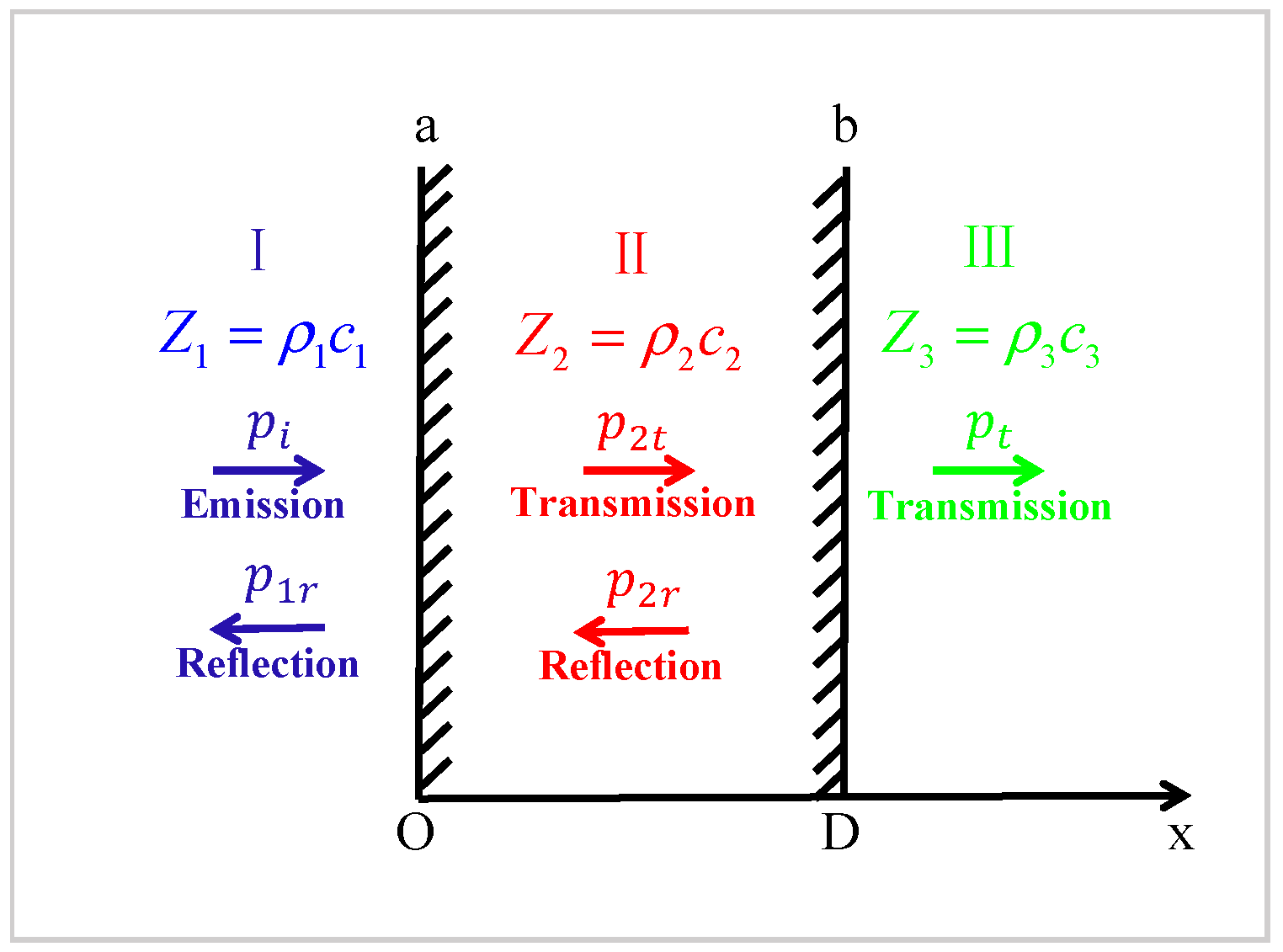

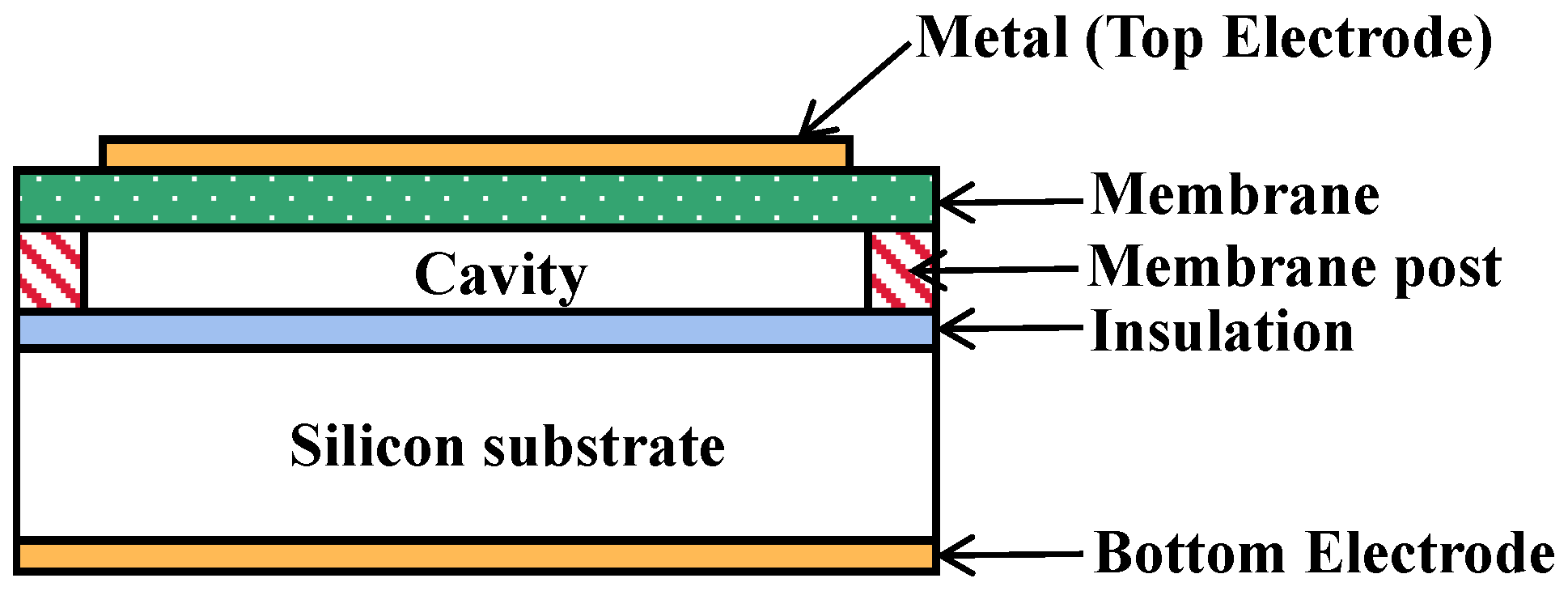
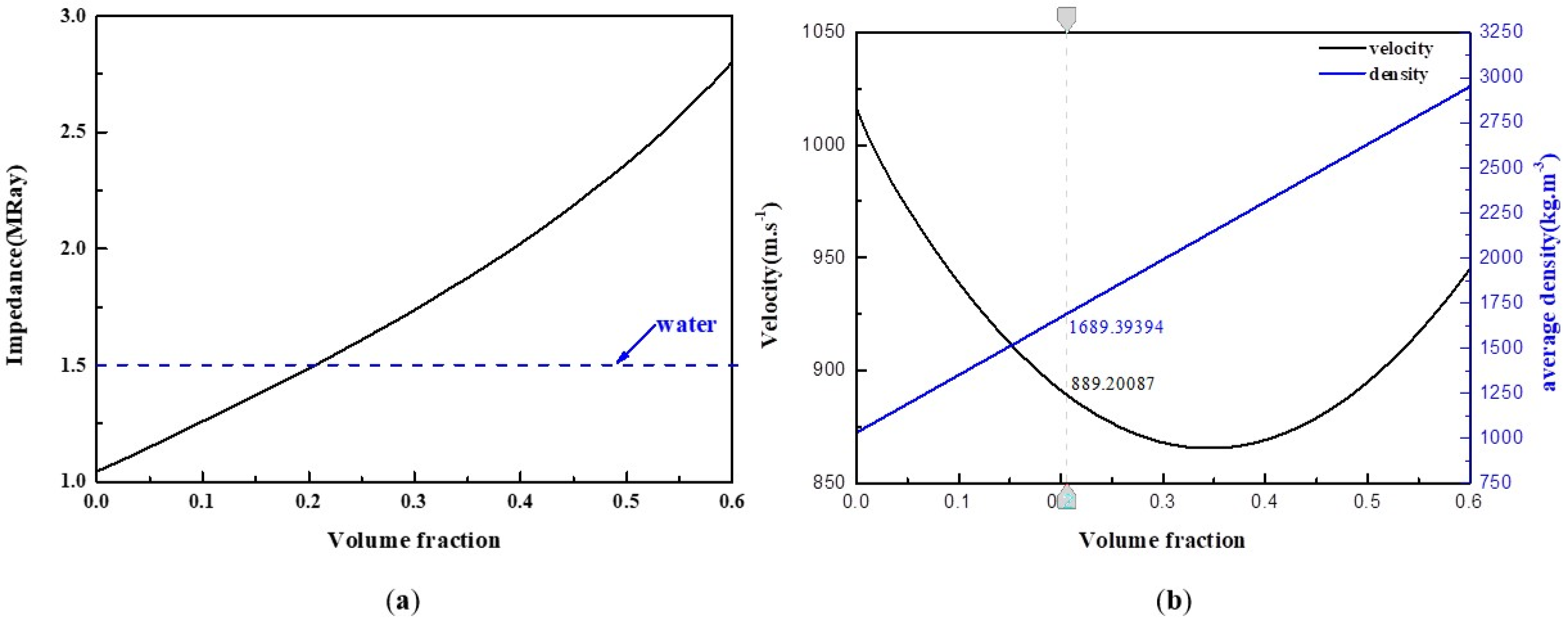

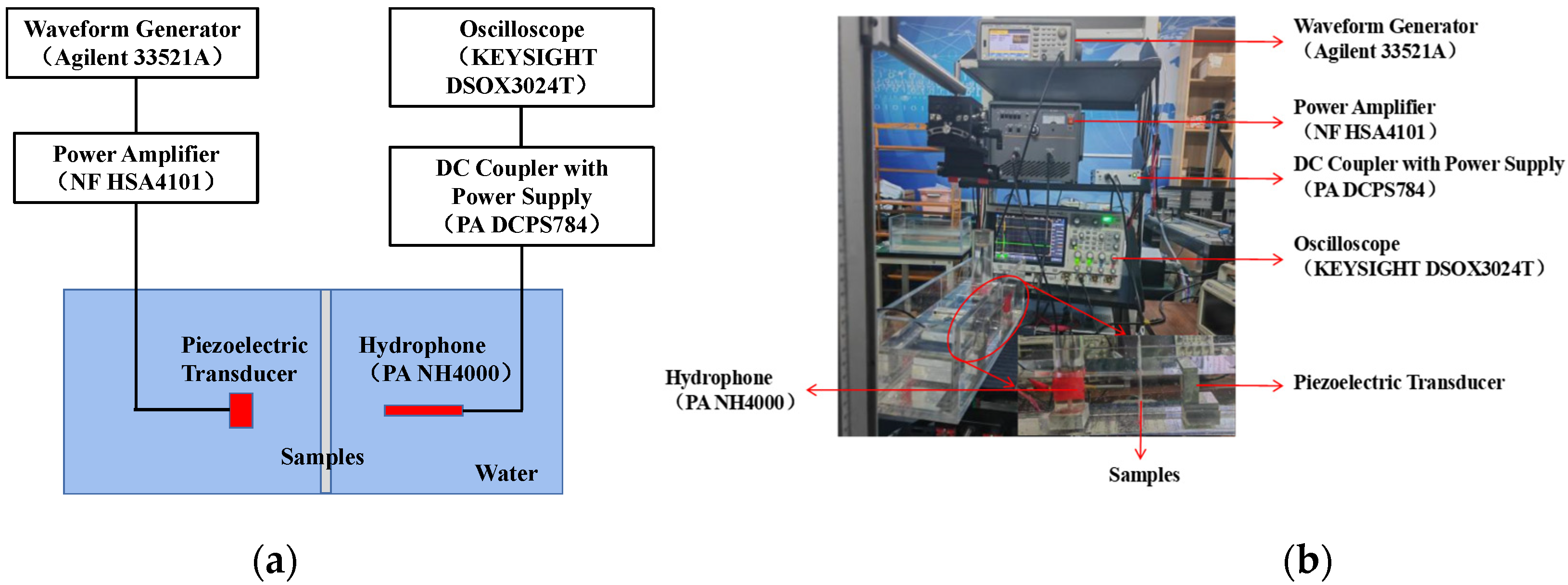


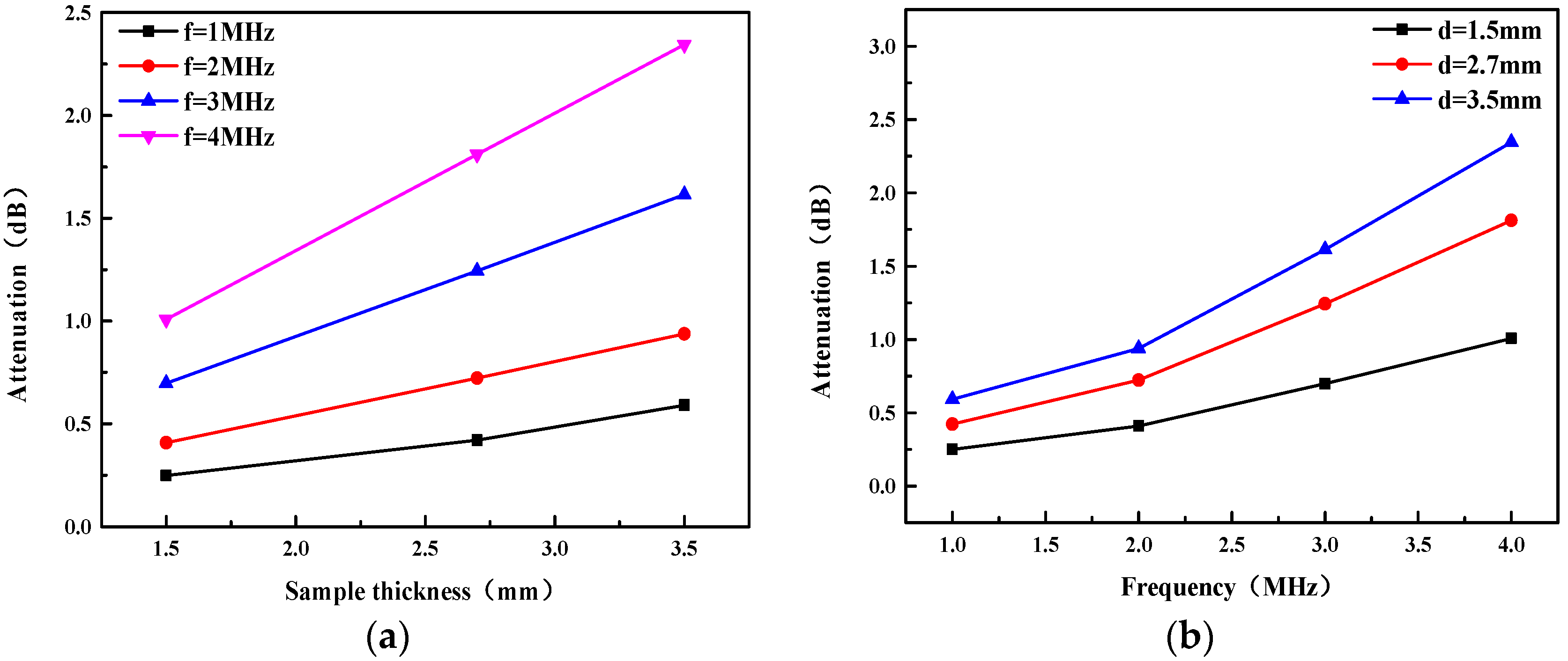
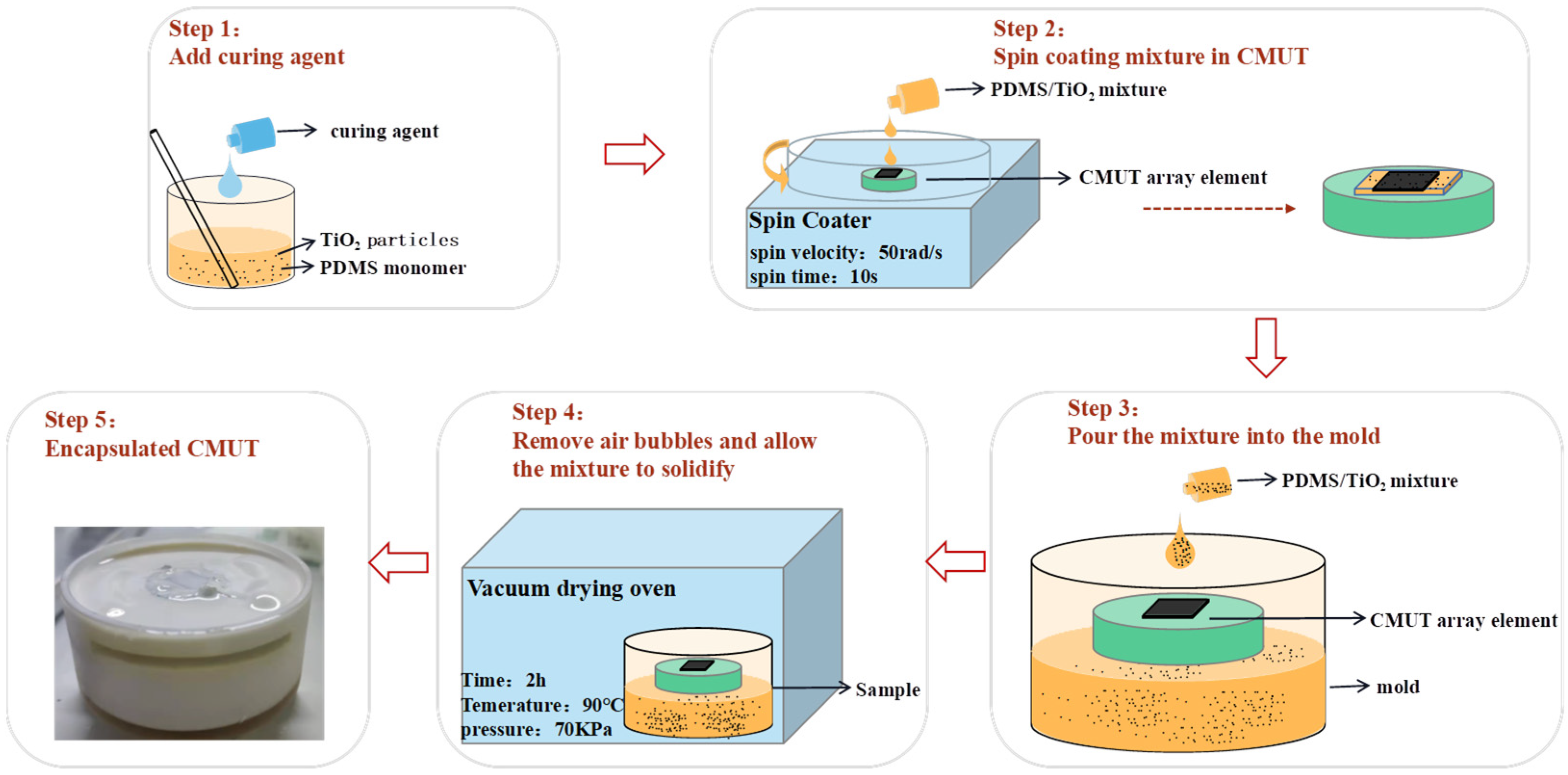




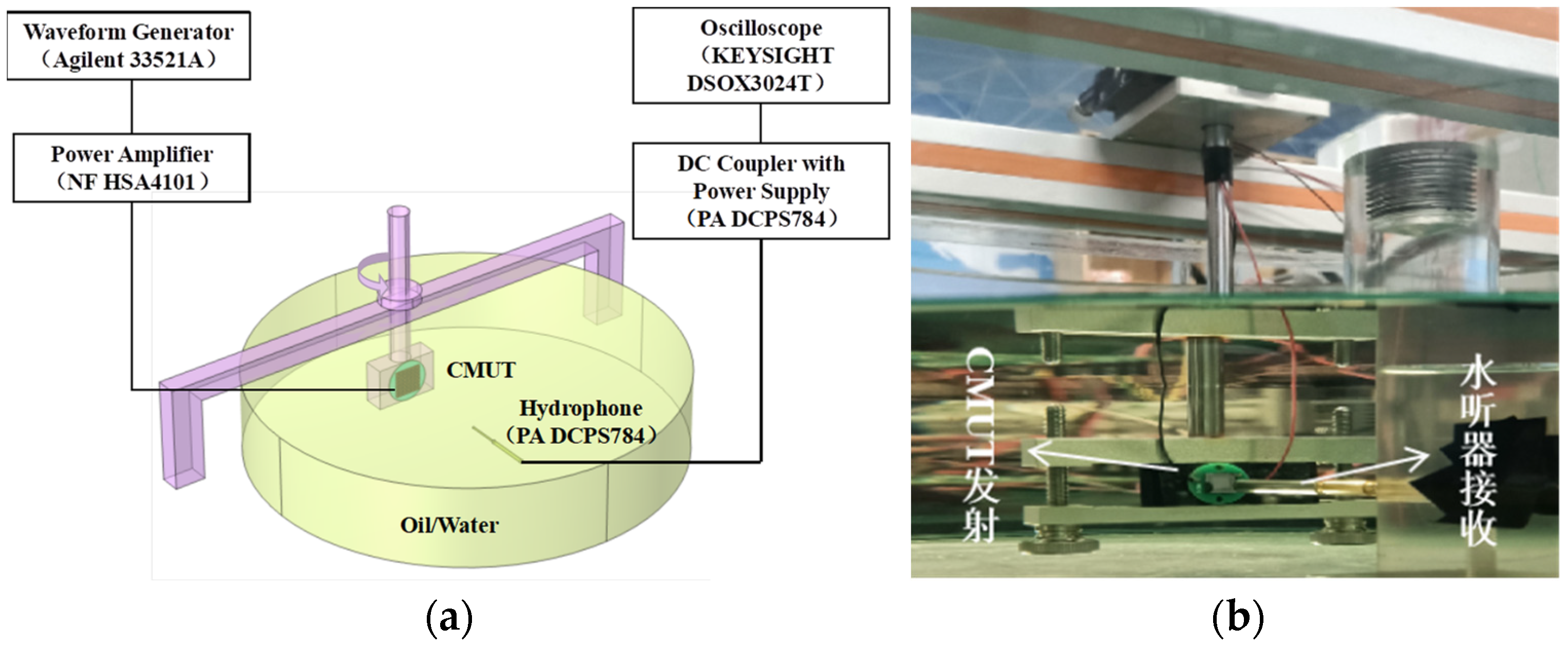



| Parameters | TiO2 (1) | PDMS (0) |
|---|---|---|
| (Pa) | 3.69 × 1011 | 1.06 × 109 |
| (Pa) | 1.0 × 106 | 4.63 × 106 |
| (Pa) | 1.15 × 1011 | 1.0 × 106 |
| (Pa) | 1.0 × 106 | 0.6 × 106 |
| (kg m−3) | 4260 | 1020 |
| Radius (nm) | <100 |
| Parameters | Values |
|---|---|
| Number of cells per device | 900 (30 × 30) |
| Silicon membrane thickness/μm | 2.83 |
| Vacuum cavity diameter/μm | 180 |
| Vacuum cavity gap distance/μm | 0.65 |
| Oxide silicon insulating dielectric thickness/μm | 0.15 |
| Metal upper electrode diameter/μm | 90 |
| Metal upper and lower electrode thickness/μm | 1 |
| Silicon substrate thickness/μm | 430 |
| Frequency/MHz | VN/mV | SN/(mV/MPa) | VC/mV | SC/(mV/MPa) | SCdB/dB |
|---|---|---|---|---|---|
| 1 | 54.5 | 1206 | 483.7 | 10,702.86 | −219.4 |
| 2 | 122.5 | 1126 | 1288.5 | 11,844.04 | −218.5 |
| 3 | 245 | 1088 | 2153 | 9560.93 | −220.4 |
| Frequency/MHz | VN/mV | SN/(mV/MPa) | VC/mV | SC/(mV/MPa) | SCdB/dB |
|---|---|---|---|---|---|
| 1 | 221 | 1206 | 1596 | 8709.63 | −221.2 |
| 2 | 264 | 1126 | 2188 | 9332.54 | −220.6 |
| 3 | 445 | 1088 | 2580.7 | 6309.57 | −224 |
Publisher’s Note: MDPI stays neutral with regard to jurisdictional claims in published maps and institutional affiliations. |
© 2022 by the authors. Licensee MDPI, Basel, Switzerland. This article is an open access article distributed under the terms and conditions of the Creative Commons Attribution (CC BY) license (https://creativecommons.org/licenses/by/4.0/).
Share and Cite
Gao, B.; Zhang, S.; He, C.; Wang, R.; Yang, Y.; Jia, L.; Wang, Z.; Wu, Y.; Hu, S.; Zhang, W. Research on Broadband Matching Method for Capacitive Micromachined Ultrasonic Transducers Based on PDMS/TiO2 Particles. Micromachines 2022, 13, 1827. https://doi.org/10.3390/mi13111827
Gao B, Zhang S, He C, Wang R, Yang Y, Jia L, Wang Z, Wu Y, Hu S, Zhang W. Research on Broadband Matching Method for Capacitive Micromachined Ultrasonic Transducers Based on PDMS/TiO2 Particles. Micromachines. 2022; 13(11):1827. https://doi.org/10.3390/mi13111827
Chicago/Turabian StyleGao, Bizhen, Sai Zhang, Changde He, Renxin Wang, Yuhua Yang, Licheng Jia, Zhihao Wang, Yang Wu, Shumin Hu, and Wendong Zhang. 2022. "Research on Broadband Matching Method for Capacitive Micromachined Ultrasonic Transducers Based on PDMS/TiO2 Particles" Micromachines 13, no. 11: 1827. https://doi.org/10.3390/mi13111827
APA StyleGao, B., Zhang, S., He, C., Wang, R., Yang, Y., Jia, L., Wang, Z., Wu, Y., Hu, S., & Zhang, W. (2022). Research on Broadband Matching Method for Capacitive Micromachined Ultrasonic Transducers Based on PDMS/TiO2 Particles. Micromachines, 13(11), 1827. https://doi.org/10.3390/mi13111827








